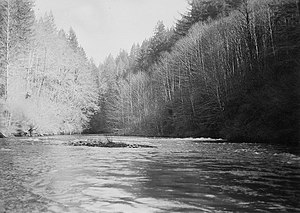| Little Sandy River | |
|---|---|
 The Little Sandy River in March 1940 | |
 Bull Run River watershed | |
| Etymology | The Sandy River, which was called Quicksand River in 1805 by Lewis and Clark because of "emence quantitys of sand" at the mouth; apparently shortened to Sandy River locally by 1845–50[2] |
| Location | |
| Country | United States |
| State | Oregon |
| County | Clackamas County |
| Physical characteristics | |
| Source | Mount Hood National Forest |
| • location | Near Hickman Butte, west of Mount Hood, Clackamas County, Oregon |
| • coordinates | 45°24′13″N 121°55′58″W / 45.40361°N 121.93278°W[1] |
| • elevation | 3,383 ft (1,031 m)[3] |
| Mouth | Bull Run River |
• location | near Bull Run, Clackamas County, Oregon |
• coordinates | 45°25′34″N 122°12′24″W / 45.42611°N 122.20667°W[1] |
• elevation | 449 ft (137 m)[1] |
| Length | 15 mi (24 km)[4] |
| Basin size | 22.3 sq mi (58 km2)[5] |
| Discharge | |
| • location | 1.95 miles (3.14 km) from the mouth[5] |
| • average | 143 cu ft/s (4.0 m3/s)[5] |
| • minimum | 8 cu ft/s (0.23 m3/s) |
| • maximum | 5,320 cu ft/s (151 m3/s) |
The Little Sandy River is a tributary, roughly 15 miles (24 km) long, of the Bull Run River in the U.S. state of Oregon.[4] Forming west of Mount Hood in the Mount Hood National Forest, it flows generally west, roughly parallel to the Sandy River to the south.[4] Its entire course lies in Clackamas County, and most of its main stem and tributaries are within the Bull Run Watershed Management Unit (BRWMU), a restricted zone that protects Portland's main water supply.
In 2008, Portland General Electric (PGE) removed the Little Sandy Dam, the only dam on the river, while decommissioning its Bull Run Hydroelectric Project. This made possible, for the first time in nearly a century, the return of migratory salmon and steelhead to the river. In 2009, both types of fish were reported spawning above the former dam site.
- ^ a b c "Little Sandy River". Geographic Names Information System (GNIS). United States Geological Survey (USGS). November 28, 1980. Retrieved December 15, 2009.
- ^ McArthur, Lewis A.; McArthur, Lewis L. (2003). Oregon Geographic Names, Seventh Edition. Portland, Oregon: Oregon Historical Society Press. pp. 846–47. ISBN 0-87595-277-1.
- ^ Source elevation derived from Google Earth search using GNIS source coordinates.
- ^ a b c Oregon Atlas and Gazetteer (Map) (2008 ed.). DeLorme Mapping. § 29–30. ISBN 978-0-89933-347-2. Approximate length determined by map scale and ruler.
- ^ a b c "USGS Water Data Report 2008: 14141500 Little Sandy River near Bull Run, OR" (PDF). United States Geological Survey. Retrieved December 15, 2009. Stated watershed size includes only that part of the watershed above river mile 1.95 (river kilometer 3.14).
